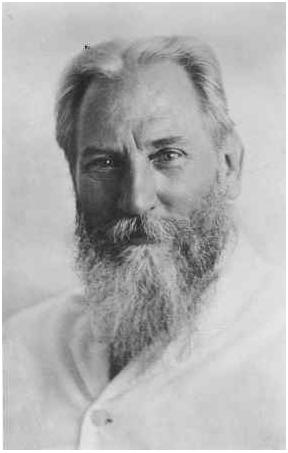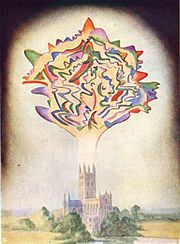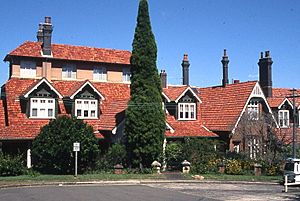Charles Webster Leadbeater facts for kids
Quick facts for kids
Charles Webster Leadbeater
|
|
|---|---|

Leadbeater in 1914 (age 60)
|
|
| Born | 16 February 1854 |
| Died | 1 March 1934 (aged 80) Perth, Australia
|
| Known for | Theosophist and writer |
Charles Webster Leadbeater (born February 16, 1854 – died March 1, 1934) was a key member of the Theosophical Society. This group explores spiritual and hidden knowledge. He also wrote many books about these subjects. With J. I. Wedgwood, he helped create the Liberal Catholic Church.
Leadbeater was first a priest in the Church of England. But he became very interested in spiritualism. This led him to leave the Anglican church. He then joined the Theosophical Society. There, he worked closely with Annie Besant. He rose to a high position in the Society. He remained a leading member until his death in 1934. He wrote over 60 books and gave many talks.
Contents
Early Life and Interests
Leadbeater was born in Stockport, England, in 1854. His father died from tuberculosis when Charles was eight. Later, the family lost their savings. This meant Leadbeater could not go to college. He started working after high school to support his mother and himself.
He worked in office jobs. In the evenings, he taught himself many things. He studied astronomy and had a large telescope. He also learned French, Latin, and Greek. In 1879, he became an Anglican priest. He was known as a kind and cheerful teacher. Around this time, he became very interested in spiritualism.
Joining the Theosophical Society
Leadbeater's interest in Theosophy grew after reading a book called Occult World. He joined the Theosophical Society in 1883. The next year, he met Helena Petrovna Blavatsky in London. She accepted him as a student. He also became a vegetarian.
He wrote a letter to Kuthumi, a spiritual teacher, asking to be his student. An encouraging reply led him to travel to India. He arrived in Adyar in 1884. He wrote that he received training from "Masters" while in India. These Masters were believed to guide the Theosophical Society. This was the start of his long career with the Society.
Work in Ceylon (Sri Lanka)
In 1885, Leadbeater traveled with Henry Steel Olcott. Olcott was the first President of the Theosophical Society. They went to Burma and Ceylon (now Sri Lanka). In Ceylon, they started the English Buddhist Academy. Leadbeater became its first headmaster. The school grew and is now Ananda College. It has over 6,000 students. A building there is named after Leadbeater.
Return to England and Key Meetings
In 1889, Leadbeater returned to England. He tutored the son of a friend and George Arundale. He brought one of his students, Curuppumullage Jinarajadasa, with him. Leadbeater helped both Arundale and Jinarajadasa go to Cambridge University. Both later became international presidents of the Theosophical Society.
After H. P. Blavatsky died in 1891, Annie Besant took over leadership of the Society. Besant met Leadbeater in 1894. She invited him to live at the Theosophical Headquarters in London.
Writing and Speaking Career
Leadbeater wrote over 60 books and pamphlets. He wrote them between 1895 and his death in 1934. Many of his books were still published years later. Two important books were Astral Plane and Devachanic Plane. These books described what happens to the soul after death.
He explored topics like:
- The existence of a loving God.
- The Masters of Wisdom (spiritual teachers).
- What happens after death.
- The idea of the human soul living forever.
- Reincarnation (being born again).
- Karma (the law of cause and effect).
- Developing clairvoyance (seeing beyond normal sight).
- The nature of thought forms.
- Dreams and vegetarianism.
- Esoteric Christianity (hidden Christian teachings).
Leadbeater was also a very popular speaker for the Theosophical Society. He served as Secretary of the London Lodge.
Clairvoyance Book

Clairvoyance is a book Leadbeater wrote in 1899. It studies the belief in seeing things beyond normal sight. Leadbeater believed that the "power to see what is hidden from ordinary physical sight" is an extension of our normal senses. He described many different types of phenomena in the book.
Changes in the Theosophical Society
In 1906, some members of the Theosophical Society asked Leadbeater to resign. He did resign. However, after Olcott died in 1907, Annie Besant became president. By the end of 1908, the Society voted to let Leadbeater rejoin. He accepted and returned to Adyar in 1909. Besant said that Leadbeater had been treated unfairly.
Discovery of Krishnamurti
In 1909, Leadbeater met fourteen-year-old Jiddu Krishnamurti. This happened at the Theosophical Society headquarters in Adyar. Krishnamurti's family lived nearby. His father worked for the Society. Leadbeater believed Krishnamurti was a good candidate to be the "vehicle" for the World Teacher. This was a spiritual leader many Theosophists expected to appear. They believed this leader would bring a new age and religion.
Leadbeater gave Krishnamurti the nickname Alcyone. He then published 30 of Alcyone's supposed past lives. These stories appeared in The Theosophist magazine starting in 1910. They covered lives from 22,662 BC to 624 AD. Alcyone was a female in eleven of these lives.
Leadbeater stayed in India until 1915. He oversaw Krishnamurti's education. Then he moved to Australia. In the late 1920s, Krishnamurti decided not to fulfill the role Leadbeater expected. He left the Theosophical Society and its teachings. He became a famous speaker on philosophy and religion.
Life in Australia and the Liberal Catholic Church
Leadbeater moved to Sydney, Australia, in 1915. He helped build the Star Amphitheatre in 1924. In Australia, he met J. I. Wedgwood. Wedgwood was a Theosophist and a bishop in the Liberal Catholic Church. Wedgwood introduced Leadbeater to Co-Masonry in 1915. He later made Leadbeater a bishop of the Liberal Catholic Church in 1916.
Interest in Theosophy grew greatly in Australia and New Zealand because Leadbeater was there. Sydney became an important center for Theosophy.

In 1922, the Theosophical Society rented a large house called The Manor. It was in Mosman, a suburb of Sydney. Leadbeater lived there and directed a community of Theosophists. The Manor became a very important place for occult studies. Young women students lived there. These included Clara Codd and Dora van Gelder, who later became presidents of the Theosophical Society in America. Mary Lutyens, who wrote a biography of Krishnamurti, also stayed there. The Manor became one of the three main Theosophical Society sites. The Society bought The Manor in 1925. It is still used by the Society today.
While in Australia, Leadbeater became the Presiding Bishop of the Liberal Catholic Church. He also helped write the church's liturgy book. This book is still used today. It changed the Roman Catholic liturgy of his time. Leadbeater removed parts he thought were not good. For example, he removed ideas of God being angry or fearful. He believed these ideas did not fit with a loving God.
He wrote that if Christians had focused on Christ's teachings, they would not have believed in an angry God. He believed God is love.
The Liberal Catholic Church liturgy written by Leadbeater says:
- "We believe that God is Love and Power and Truth and Light; that perfect justice rules the world; that all His sons shall one day reach His Feet, however far they stray. We hold the Fatherhood of God, the Brotherhood of man; we know that we do serve Him best when best we serve our brother man. So shall His blessing rest upon us and peace for evermore. Amen."
Leadbeater also wrote The Science of the Sacraments. This book explored the energies of Christian sacraments. It is an important work in Christian esotericism. It presents a new way to understand the Eucharist. It shows Catholicism as expressing God's love fully.
Legacy
Leadbeater is still well-known in New Age groups. His many books are based on his clairvoyant investigations. These include books like Outline of Theosophy, Astral Plane, Devachanic Plane, The Chakras, and Man, Visible and Invisible. These books cover basic Theosophy, what happens after death, the chakra system, and the human aura.
His writings on sacraments and Christian esotericism are still popular. New editions and translations of The Science of the Sacraments are always being made. His liturgy book is still used by some Liberal and Independent Catholic Churches.
Selected Writings
- Dreams (What they are and how they are caused) (1893)
- Theosophical Manual Nº5: The Astral Plane (Its Scenery, Inhabitants and Phenomena) (1896)
- Theosophical Manual Nº6: The Devachanic Plane or The Heaven World Its Characteristics and Inhabitants (1896)
- Invisible Helpers (1896)
- Reincarnation (1898)
- Our Relation to Our Children (1898)
- Clairvoyance (1899)
- An Outline of Theosophy (1902)
- Man Visible and Invisible (1902)
- Some Glimpses of Occultism, Ancient and Modern (1903)
- The Christian Creed (1904)
- Thought Forms (with Annie Besant) (1905)
- Occult Chemistry (with Annie Besant) (1908)
- The Inner Life (1911)
- The Perfume of Egypt and Other Weird Stories (1911)
- The Power and Use of Thought (1911)
- The Life After Death and How Theosophy Unveils It (1912)
- A Textbook of Theosophy (1912)
- Man: Whence, How and Whither (with Annie Besant) (1913)
- Vegetarianism and Occultism (1913)
- The Hidden Side of Things (1913)
- Australia & New Zealand: Home of a new sub-race (1916)
- The Monad and Other Essays Upon the Higher Consciousness (1920)
- The Inner Side of Christian Festivals (1920)
- The Science of the Sacraments (1920)
- The Lives of Alcyone (with Annie Besant) (1924)
- The Liturgy According to the Use of the Liberal Catholic Church (with J.I. Wedgwood) (Second Edition) (1924)
- The Masters and the Path (1925)
- Talks on the Path of Occultism (1926)
- Glimpses of Masonic History (1926) (later pub 1986 as Ancient Mystic Rites)
- The Hidden Life in Freemasonry (1926)
- The Chakras (1927) (published by the Theosophical Publishing House, Wheaton, Illinois, USA)
- Spiritualism and Theosophy Scientifically Examined and Carefully Described (1928)
- The Noble Eightfold Path (1955)
- Messages from the Unseen (1931)
See also
 In Spanish: Charles Webster Leadbeater para niños
In Spanish: Charles Webster Leadbeater para niños
- Chakras
- Clairvoyance
- Christian mythology
- Reincarnation
- Theosophy and Christianity

